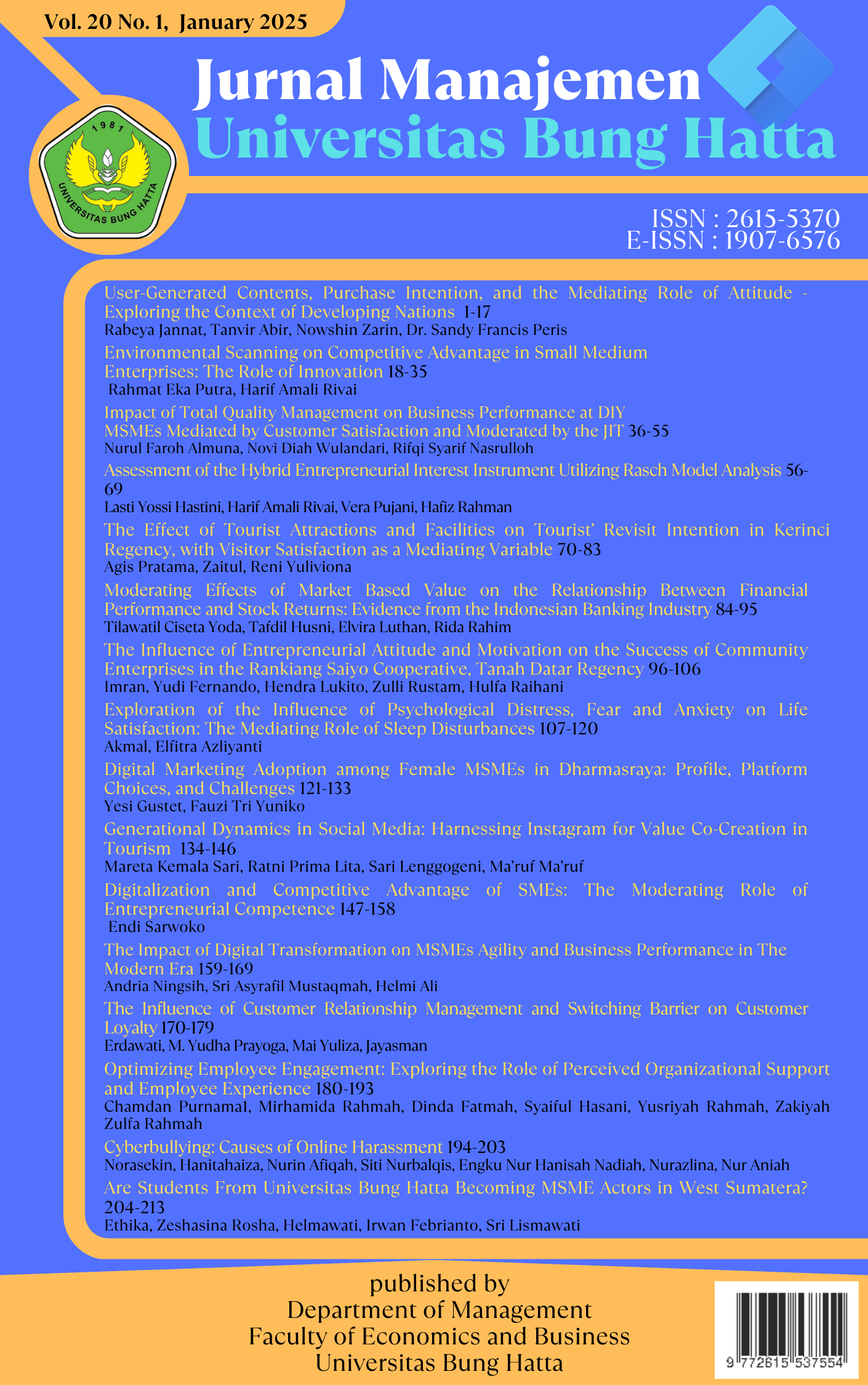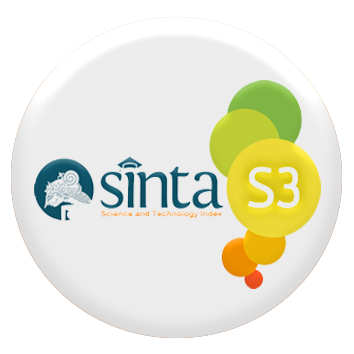Environmental Scanning on Competitive Advantage in Small Medium Enterprises: The Role of Innovation
DOI:
https://doi.org/10.37301/jmubh.v20i1.25509Keywords:
environmental scanning, innovative performance, competitive advantage, SMEsAbstract
Innovation is the main key in achieving competitive advantage in business. Due to the dynamic business environment, small and medium enterprises (SMEs) must prioritize innovation to sustain their competitive advantage. This report offers a comprehensive perspective on how SMEs may effectively cope with any changes and sustain their competitive advantage through innovation. Therefore, explaining the main predictors of innovation in achieving competitive advantage in a dynamic environment is important to do. Through organizational information processing theory (OIPT), this study proposes environmental scanning as the main predictors in explaining innovative performance which in turn has an impact on competitive advantage. Data were collected from 245 SMEs in Indonesia from various industries. Testing the proposed hypothesis of the research was assessed with SEM by assisting Amos software. The results indicated that environmental scanning positively influence competitive advantage. Further the findings were also supported that innovative performance significantly mediates this relationship. This is a cross-sectional research study with a non-probability random sampling method, and self-report questionnaires, therefore possible bias may occur in the research findings. Implications of the research were also discussed in this paper.
References
Alatarvas, T., Podor, R., Heikkinen, E. P., Shu, Q., & Singh, H. (2023). Revealing the kinetics of non-metallic inclusion reactions in steel using in-situ high temperature environmental scanning electron microscopy. Materials and Design, 232. https://doi.org/10.1016/j.matdes.2023.112139
Albright, K. (2004). Environmental Scanning: Radar for Success. The Information Management Journal, 38–45. https://www.researchgate.net/publication/239970846
Alraja, M. N., Imran, R., Khashab, B. M., & Shah, M. (2022). Technological Innovation, Sustainable Green Practices and SMEs Sustainable Performance in Times of Crisis (COVID-19 pandemic). Information Systems Frontiers, 24(4), 1081–1105. https://doi.org/10.1007/s10796-022-10250-z
Amabile, M. T. (1988). A Model of creativity and innovation in organizations. Research in Organizational Behavior, 10, 123–167.
Ambe, I. M. (2010). Agile Supply Chain: Strategy for Competitive Advantage. Journal of Global Strategic Management, 1(4), 5–5. https://doi.org/10.20460/jgsm.2010415835
Andriopoulos, C., & Gotsi, M. (2006). Probing the future: Mobilising foresight in multiple-product innovation firms. Futures, 38(1), 50–66. https://doi.org/10.1016/j.futures.2005.04.003
Anning-Dorson, T. (2018). Innovation and competitive advantage creation: The role of organisational leadership in service firms from emerging markets. International Marketing Review, 35(4), 580–600. https://doi.org/10.1108/IMR-11-2015-0262
Barney, J. B. (2002). Strategic Management: From Informed Conversation to Academic Discipline. 16(2), 53–57.
Baron, R. M., & Kenny, D. A. (1986). The Moderator-Mediator Variable Distinction in Social Psychological Research: Conceptual, Strategic, and Statistical Considerations. In Journal of Personality and Social Psychology (Vol. 51, Issue 6).
Battor, M., & Battor, M. (2010). The impact of customer relationship management capability on innovation and performance advantages: Testing a mediated model. Journal of Marketing Management, 26(9–10), 842–857. https://doi.org/10.1080/02672570903498843
Bhardwaj, S. S., & Kumar, D. (2014). Environmental Scanning by FMCG Companies in India: A Comparitive Study. In International Journal of Management and International Business Studies (Vol. 4, Issue 1). http://www.ripublication.com
Blaique, L., Abu-Salim, T., Asad Mir, F., & Omahony, B. (2024). The impact of social and organisational capital on service innovation capability during COVID-19: the mediating role of strategic environmental scanning. European Journal of Innovation Management, 27(1), 1–26. https://doi.org/10.1108/EJIM-01-2022-0023
Börjesson, S., Dahlsten, F., & Williander, M. (2006). Innovative scanning experiences from an idea generation project at Volvo Cars. Technovation, 26(7), 775–783. https://doi.org/10.1016/j.technovation.2005.01.005
Cancellier, É. L. P. D. L., Junior, E. J. B., & Rossetto, C. R. (2014). Environmental scanning, strategic behaviour, organizational characteristics, and performance in small firms. Journal of Information Systems and Technology Management, 11(3). https://doi.org/10.4301/s1807-17752014000300006
Cáñez, L., Puig, L., Quintero, R., & Garfias, M. (2007). Linking Technology Acquisition To A Gated NPD Process The Mexican oil industry finds an alternative way of delivering technology-based solutions. www.imp.mx.
Choo, C. W. (2001). Environmental scanning as information seeking and organizational learning. Information Research, 7(1).
Cohen, W. M., & Levinthal, D. A. (1990). Absorptive Capacity: A New Perspective on Learning and Innovation. In Source: Administrative Science Quarterly (Vol. 35, Issue 1).
Cousins, P. D., Lawson, B., Petersen, K. J., & Handfield, R. B. (2011). Breakthrough Scanning, Supplier Knowledge Exchange, and New Product Development Performance. J Prod Innov Manag, 28, 930–952.
Dada, O. (Lola), & Fogg, H. (2016). Organizational learning, entrepreneurial orientation, and the role of university engagement in SMEs. International Small Business Journal: Researching Entrepreneurship, 34(1), 86–104. https://doi.org/10.1177/0266242614542852
Daft, R. L., & Lengel, R. H. (1986). Management Science (1986-1998) (Vol. 32, Issue 5). ABI/INFORM Global.
Daft, R. L., Sormunen, J., & Parks, D. (1988). Chief Executive Scanning, Environmental Characteristics, and Company Performance: An Empirical Study. Strategic Management Journal, 9, 123–139.
De Geus, A. P. (1988). Planning as leaerning. Harvard Business Review, 70–74.
Diab, Salah. M. (2014). Using the Competitive Dimensions to Achieve Competitive Advantage A Study on Jordanian Private Hospitals. International Journal of Academic Research in Business and Social Sciences, 4(9). https://doi.org/10.6007/ijarbss/v4-i9/1136
Dixon, S., Meyer, K., & Day, M. (2014). Building dynamic capabilities of adaptation and innovation: A study of micro-foundations in a transition economy. Long Range Planning, 47(4), 186–205. https://doi.org/10.1016/j.lrp.2013.08.011
Doyle, P., & Wong, V. (1998). Marketing and competitive performance: an empirical study. European Journal of Marketing, 32, 514–535.
Duchek, S. (2020). Organizational resilience: a capability-based conceptualization. Business Research, 13(1), 215–246. https://doi.org/10.1007/s40685-019-0085-7
Dustin, G., Bharat, M., & Jitendra, M. (2014). Competitive Advantage and Motivating Innovation. In Advances In Management (Vol. 7, Issue 1).
El Hadi, M. M. (2016). Toward Egyptian SMEs’ Maturity and Readiness for IT Adoption in the New World of Globalization. Compunet ( The Egyptian Information Journal ), 15(17), 5–16. https://doi.org/10.12816/0031962
Erhan, T., Uzunbacak, H. H., & Aydin, E. (2022). From conventional to digital leadership: exploring digitalization of leadership and innovative work behavior. Management Research Review. https://doi.org/10.1108/MRR-05-2021-0338
Flynn, B. B., & Flynn, E. J. (1999). Information-Processing Alternatives for Coping with Manufacturing Environment Complexity. Decision Sciences, 30(4), 1021–1052.
Fraser, K. T., Ilieva, R. T., James, C. J., Chong, V. P., Shapiro, S., Willingham, C., Roberts, C., & Freudenberg, N. (2022). Use of environmental scan to assess density, content, and variation of predatory food and beverage marketing in New York City. Health and Place, 76. https://doi.org/10.1016/j.healthplace.2022.102843
Gable, M., & Topol, M. T. (1987). Planning Practices of Smaii-Scaie Retailers.
Galbraith, Jay. R. (1973). Designing Complex Organization (1st ed.).
Grimpe, C., & Sofka, W. (2009). Search patterns and absorptive capacity: Low- and high-technology sectors in European countries. Research Policy, 38(3), 495–506. https://doi.org/10.1016/j.respol.2008.10.006
Haarhaus, T., & Liening, A. (2020). Building dynamic capabilities to cope with environmental uncertainty: The role of strategic foresight. Technological Forecasting and Social Change, 155. https://doi.org/10.1016/j.techfore.2020.120033
Hair, J. F., Black, W. C., Babin, B. J., & Anderson, R. E. (2014). Multivariate Data Analysis. In Prentice-Hall, Inc (7th ed.). Pearson Education Limited. https://doi.org/10.1038/259433b0
Hambrick, D. C. (1982). Environmental Scanning and Organizational Strategy. Strategic Management Journal, 3, 159–160.
Hamsal, M., & Ichsan, M. (2021). Business sustainability in the times of crisis: Propositions and framework. IOP Conference Series: Earth and Environmental Science, 729(1). https://doi.org/10.1088/1755-1315/729/1/012049
Hansen, M. T. (2002). Knowledge Networks: Explaining Effective Knowledge Sharing in Multiunit Companies. Organization Science, 13(3), 232–248.
Helfat, C. E., & Peteraf, M. A. (2002). The Dynamic Resource-Based View: Capability Lifecycles The Dynamic Resource-Based View: Capability Lifecycles 1 Forthcoming Strategic Management Journal. http://ssrn.com/abstract=386620
Henard, D. H., & Szymanski, D. M. (2001). Why Some New Products Are More Successful Than Others. In Source: Journal of Marketing Research (Vol. 38, Issue 3).
Hidalgo, J. J. P., & Centeno, J. A. S. (2023). Environmental scanning of cocaine trafficking in Brazil: Evidence from geospatial intelligence and natural language processing methods. Science and Justice, 63(6), 689–723. https://doi.org/10.1016/j.scijus.2023.09.002
Higón, D. A. (2012). The impact of ICT on innovation activities: Evidence for UK SMEs. International Small Business Journal, 30(6), 684–699. https://doi.org/10.1177/0266242610374484
Hirschi, G., & Jones, M. (2009). Affects of strategic leadership on business success - a cross-cultural analysis from a resource based view. MIBES Transactions, 3(1), 1–18. https://ro.uow.edu.au/buspapers
Ho, L. A. (2011). Meditation, learning, organizational innovation and performance. Industrial Management and Data Systems, 111(1), 113–131. https://doi.org/10.1108/02635571111099758
Howel, Jane. M., & Shea, Christine. M. (2021). Individual differences, environmental scanning, innovation framing, and champion behavior: key predictors of project performance. The Jornal of Product Innovation Management, 18, 15–27.
Ireland, R. D., Covin, J. G., & Kuratko, D. F. (2009). Conceptualizing Corporate Entrepreneurship Strategy.
Jiménez-Jiménez, D., & Sanz-Valle, R. (2011). Innovation, organizational learning, and performance. Journal of Business Research, 64, 408–417. https://doi.org/10.1016/j.jbusres.2010.09.010
Kiss, A., Zhang, Q., Carley, M., Smith, M., Légaré, F., Archambault, P., & Stacey, D. (2023). Quality of patient decision aids to support the public making COVID-19 decisions: An online environmental scan. Patient Education and Counseling, 114. https://doi.org/10.1016/j.pec.2023.107797
Koberg, C. S., Uhlenbruck, N., & Sarason, Y. (1996). Facilitators Of Organizational Innovation: The Role Of Life-Cycle Stage.
Lee, J.-S., & Hsieh, C.-J. (2010). A Research In Relating Entrepreneurship, Marketing Capability, Innovative Capability And Sustained Competitive Advantage. Journal of Business & Economics Research, 8(9), 109.
Li, S., Ragu-Nathan, B., Ragu-Nathan, T. S., & Subba Rao, S. (2006). The impact of supply chain management practices on competitive advantage and organizational performance. Omega, 34(2), 107–124. https://doi.org/10.1016/j.omega.2004.08.002
Martin-Rios, C. (2016). Human Resource Management, or Research in Personnel and Human Resource Management. Running Heads: Sensemaking in a Public Research Organization 1 1 Accepted at International Journal of Organizational Analysis. In International Journal of Organizational Analysis (Vol. 24).
Nady, B. A.-H. A. Al, Haraizah, A. S. Al, & Hawary, S. I. S. Al. (2014). Environmental Scanning and Communication Technology as a Gate for Sustainable Competitive advantage of Sanitary Ware (bathtub) Suppliers in Kingdom of Saudi Arabia. International Journal of Computers & Technology, 13(3), 4335–4353. https://doi.org/10.24297/ijct.v13i3.2764
Ologbenla, P. (2022). Assessment of the Impact of Environmental Scanning Intensity on Innovation among SMEs Owners in Oyo State Nigeria. International Journal of Scientific and Management Research, 05(08), 104–114. https://doi.org/10.37502/ijsmr.2022.5810
O’Regan, N., & Ghobadian, A. (2006). Perceptions of generic strategies of small and medium sized engineering and electronics manufacturers in the UK: The applicability of the Miles and Snow typology. Journal of Manufacturing Technology Management, 17(5), 603–620. https://doi.org/10.1108/17410380610668540
Podsakoff, P. M., MacKenzie, S. B., Lee, J. Y., & Podsakoff, N. P. (2003). Common Method Biases in Behavioral Research: A Critical Review of the Literature and Recommended Remedies. In Journal of Applied Psychology (Vol. 88, Issue 5, pp. 879–903). https://doi.org/10.1037/0021-9010.88.5.879
Porter, M. E., & Millar, V. E. (1985). How information gives you competitive advantage. Harvard Business Review, 63(4), 149–158.
Porter, M. E., & Van Der Linde, C. (1995). Green and Competitive: Ending the Stalemate Harvard Business Review.
Porter, Michael. E. (1990). Competitive Advantage of Nations. Harvard Business Review, 73–93.
Pulgarín Medina, S. A., & Guerrero, N. A. (2017). Innovation and competitiveness: organizational culture and business model. Dimensión Empresarial, 15(2). https://doi.org/10.15665/rde.v15i2.1023
Puspita, L. E., Christiananta, B., & Ellitan, L. (2020). The effect of strategic orientation, supply chain capability, innovation capability on competitive advantage and performance of furniture retails. International Journal Of Scientific & Technology Research, 9(3), 4521–4529. www.ijstr.org
Putra, R. E., Neswardi, S., Primadona, R., Jumyetti, T., & Yuanita, I. (2023). Impact Of Digital Leadership on Small Medium Enterprises Resilience: The Mediating Role of Employee Creativity. Andalas Management Review, 7(1), 35–61.
Ramaswami, S. N., Srivastava, R. K., & Bhargava, M. (2009). Market-based capabilities and financial performance of firms: Insights into marketing’s contribution to firm value. Journal of the Academy of Marketing Science, 37(2), 97–116. https://doi.org/10.1007/s11747-008-0120-2
Ruff, F. (2006). Corporate foresight: integrating the future business environment into innovation and strategy. In Int. J. Technology Management (Vol. 34).
Sivadas, E., & Dwyer, F. R. (2000). An Examination of Organizational Factors Influencing New Product Success in Internal and Alliance-Based Processes. In Journal of Marketing (Vol. 64).
Subramanian, R., Fernandes, N., Earl, /, Mir, H., & Harper, E. (1993). Environmental Scanning in U.S. Companies: Their Nature and Their Relationship to Performance mir (Vol. 33, Issue 3).
Sunhilde, C. (2011). Achieving Competitive Advantage through Using an Integrated Multi-selling Model. The Case from Romanian Linjerie Producer: Jolidon. 4(1).
Tang, J., Kacmar, K. M. M., & Busenitz, L. (2012). Entrepreneurial alertness in the pursuit of new opportunities. Journal of Business Venturing, 27(1), 77–94. https://doi.org/10.1016/j.jbusvent.2010.07.001
Tang, J., Pee, L. G., & Iijima, J. (2013). Investigating the effects of business process orientation on organizational innovation performance. Information and Management, 50(8), 650–660. https://doi.org/10.1016/j.im.2013.07.002
Tang, T. W. (2014). Becoming an ambidextrous hotel: The role of customer orientation. International Journal of Hospitality Management, 39, 1–10. https://doi.org/10.1016/j.ijhm.2014.01.008
Van De Ven, A. H., New, W. F. J., Wiley, Y. :, & Appleton, L. M. (1983). 440 BOOK REVIEWS Perspectives on Organization Design and Be-havior, edited by. In Contemporary Sociology (Vol. 12).
Vargo, S. L., & Lusch, R. F. (2017). Service-dominant logic 2025. International Journal of Research in Marketing, 34(1), 46–67. https://doi.org/10.1016/j.ijresmar.2016.11.001
von der Gracht, H. A., Vennemann, C. R., & Darkow, I. L. (2010). Corporate foresight and innovation management: A portfolio-approach in evaluating organizational development. Futures, 42(4), 380–393. https://doi.org/10.1016/j.futures.2009.11.023
Wang, R., Ma, S., Xu, X., & Song, P. (2021). Heterogeneous shareholders’ participation, covid-19 impact, and innovation decisions of state-owned firms: Evidence from china. Sustainability (Switzerland), 13(8). https://doi.org/10.3390/su13084406
Williams, M. (2007). Genuine Trust Through Building Management: Emotion Interpersonal and Model of Trust Regulation Across Boundaries Collaboration. Academy of Management Review, 32(2), 595–621. https://doi.org/10.5465/amr.2007.24351867
Wu, K. J., Tseng, M. L., Chiu, A. S. F., & Lim, M. K. (2017). Achieving competitive advantage through supply chain agility under uncertainty: A novel multi-criteria decision-making structure. International Journal of Production Economics, 190, 96–107. https://doi.org/10.1016/j.ijpe.2016.08.027
Xin, X., & Ny Avotra, A. A. R. (2023). Role of environmental ownership and associated parameters to assess green patents in technologies with environmental scanning system as a controlling factor. Environmental Research, 227. https://doi.org/10.1016/j.envres.2023.115809
YahiaMarzouk, Y., & Jin, J. (2022). Linking environmental scanning and organizational innovation with competitive advantage: evidence from Egyptian SMEs. Management and Sustainability:, 1(2), 170–195. https://doi.org/10.1108/MSAR-02-2022-0010
Yoo, S.-J., & Sawyerr, O. (2014). The Search for Broad Environmental Information and New Product Development Success in Technology-Based SMEs. Journal of Enterprising Culture, 22(01), 27–55. https://doi.org/10.1142/s0218495814500022
Yu, W., Chavez, R., Jacobs, M., Wong, C. Y., & Yuan, C. (2019). Environmental scanning, supply chain integration, responsiveness, and operational performance: An integrative framework from an organizational information processing theory perspective. International Journal of Operations and Production Management, 39(5), 787–814. https://doi.org/10.1108/IJOPM-07-2018-0395
Zhang, X., Majid, S., & Foo, S. (2011). Foo • The Contribution of Environmental Scanning to Organizational Performance Singapore Journal of Library & Information Management • (Vol. 40).
Downloads
Published
Issue
Section
License
Copyright (c) 2025 Rahmat Eka Putra, Harif Amali Rivai

This work is licensed under a Creative Commons Attribution-ShareAlike 4.0 International License.
Authors who publish with Jurnal Manajemen Universitas Bung Hatta agree to the following terms:
- Authors retain copyright and grant the journal right of first publication with the work simultaneously licensed under a Creative Creative Commons Attribution-ShareAlike 4.0 International License that allows others to share the work with an acknowledgement of the work's authorship and initial publication in Jurnal Manajemen Universitas Bung Hatta.
- The author holds the copyright of the submitted and published articles, with the understanding that articles are disseminated under the Creative Commons Attribution-ShareAlike 4.0 International License..
- The editor team is entitled to do the editing in accordance with the guidelines for writing or template in the Jurnal Manajemen Universitas Bung Hatta.
This work is licensed under a Creative Commons Attribution-ShareAlike 4.0 International License.












